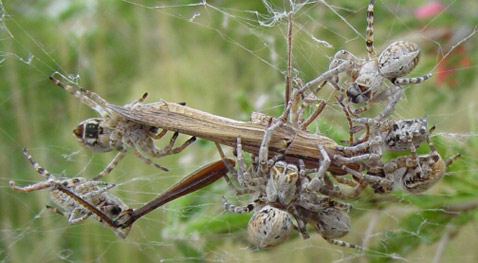Social Spiders
Austen Brown and Jenny Eng
Mechanism
Mechanism addresses the process by which a species carries out a certain behavior. Several well studied behaviors unique to social spiders are group foraging, extended maternal care and mating, and their mechanisms are explained below.
Foraging
Because group foraging behavior is rare in spiders, it is interesting to study the mechanism behind this behavior and how it is different from other animal communication. Like other insects, spiders communicate during courtship behavior with chemical and vibrational cues. Although it has been hypothesized that spiders may use vibrations to signal the need for assistance in prey capture (14), it has now been clearly demonstrated that this is not the case. In 2001, Vakanas and Krafft published an experiment that described the likely mechanism in which the social spider Anelosimus eximius is able to coordinate group prey capture (15). By observing the prey capture behavior of groups and individuals in naturally and artificially vibrated situations at different stages of prey capture, Vakanas and Krafft were able to conclude that this species of social spider could coordinate group prey capture without the use of complicated signals. Instead, each individual reacts the prey individually and carries out a simple, pre-established strategy of prey capture. Thus signals about the overall situation were not required.

S. dumicola. Image taken from Reference 4
Maternal Care
The mechanism by which maternal care is carried out varies among the social and sub-social species. Mor Salomon and Yael Lubin (2007) demonstrated that cooperative caring for the young occurs in the social spider S. dumicola, increasing the fitness of the young (16). By placing the spiders in a sex skewed situation with only one reproducing female, it was shown that more than not one adult female participated in regurgitating food for the young and more importantly that almost all females participated in matriphagy, the eating of the mother by the young. The young in this group of spiders was compared to a control group that only had one mother, revealing that the young who were cooperatively raised were much larger and thus had a higher survival rate.
Mating
Since social spiders must extensively cooperate, mating and aggressive behaviors are expected to be more ritualized, minimizing risk of injury while allowing a compromise of conflicts of interest. Such complex courtship behavior is seen in males belonging to the Therididae species Achaeranea wau. Courtship includes construction of a special web section to which the male applies sperm, a period of "searching" during which the male makes frequent contact with females, and a display that includes abdomen vibrations and "twanging" on web (17). Males competing through abdomen vibrating often progressed bouts of group sparring, a behavior unusual in non- social spiders (17). It is hypothesized that because of their sociality, these spiders are able to engage in ritual fights without hurting each other (17).
Elaborate courtship in social spiders and the high degree of female choice leads to higher variability in male mating success (17). This results in a higher frequency of alternative mating tactics (17). Males who face face a high probability of rejection engage in opportunistic mating, which includes copulation with females who are eating or in an extreme case, molting, during which a female is left completely defenseless and several males will force copulation in succession (17).